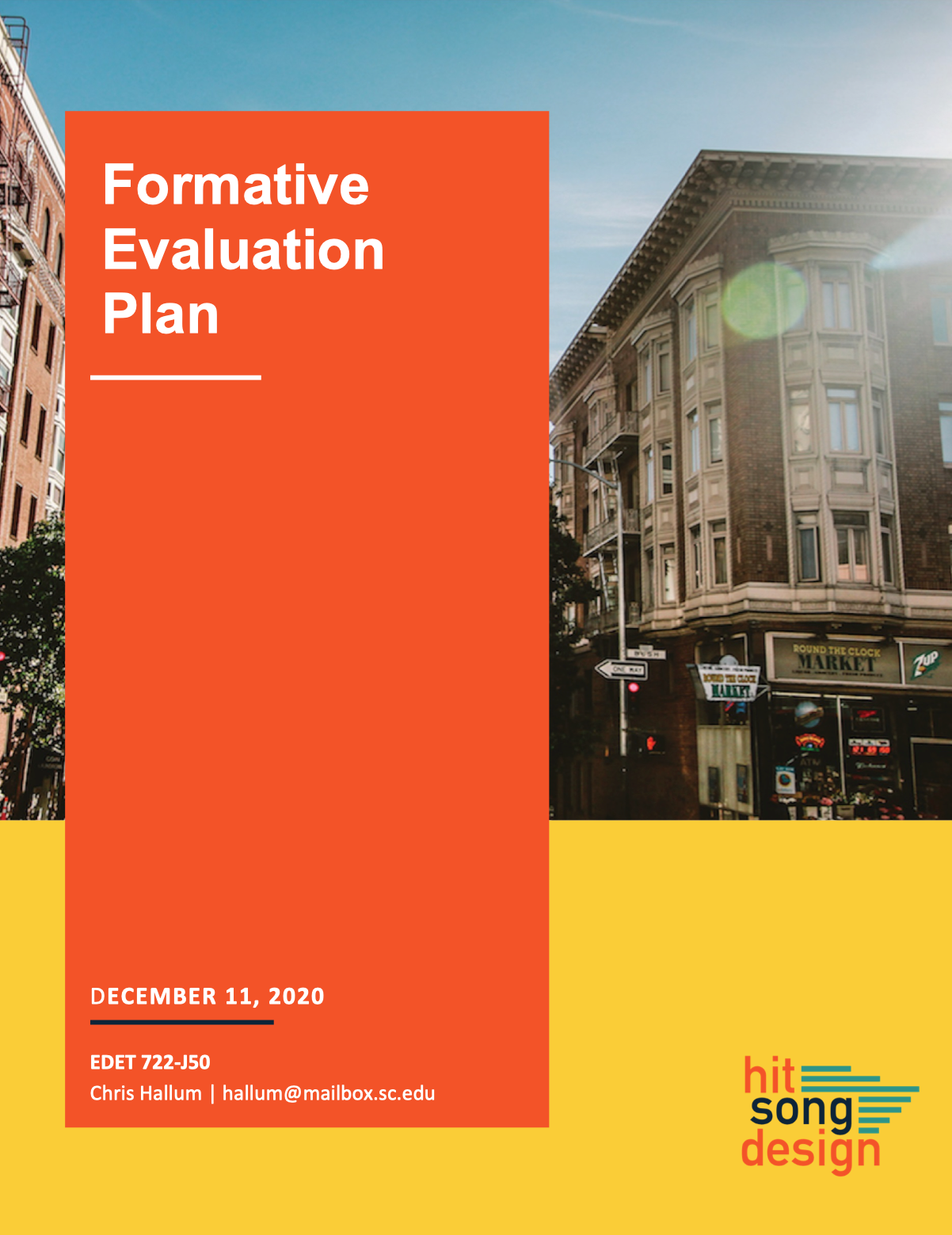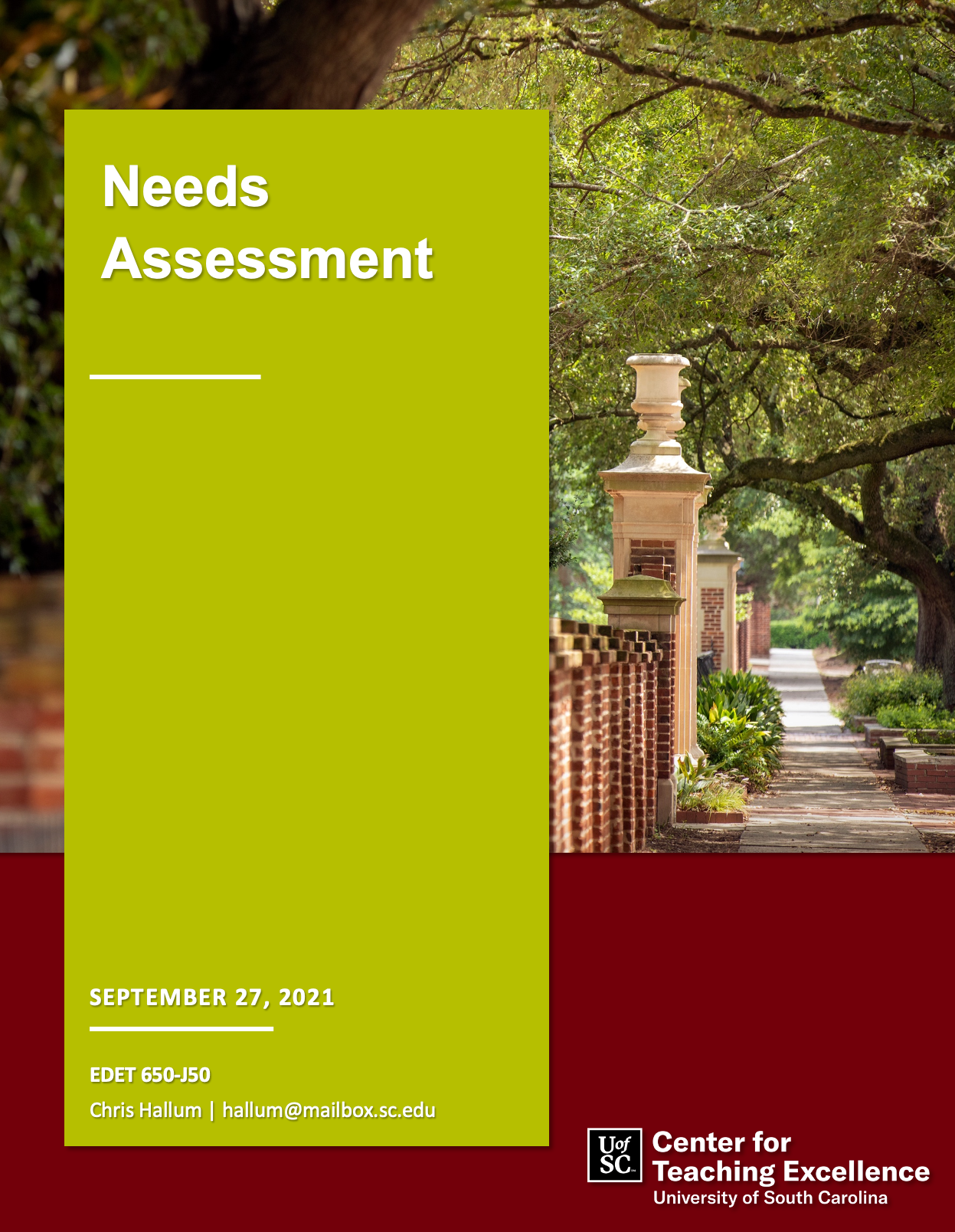AECT Standard 5
Early (novice) example
The Formative Evaluation Plan that I created for EDET 722 is my first attempt at a full-length formative evaluation plan following the Morrison et al. (2019) model. The instruction that was created as a result of this plan represents a complete curriculum, or a complete level of a curriculum that has grown in several levels since then (e.g., the Composition for Songwriters course that I made for EDET 755 was a logical next step in the curriculum plan). As a trained composer, I brought my multiple decades of music knowledge and music education experience to bear as I completed this project; because of this, I served as the instructional designer, developer, SME.
This Formative Evaluation Plan directly follows the Morrison et al., (2019) model for analyzing learners, creating tasks, assessing learners, etc, and it also reflects the “Method” indicator included under AECT Standard 5 – Research (Januszewski, Molenda, et al., 2008, as cited in AECT Standards, 2012 Version, n.d.). The more granular tasks and steps outlined in the plan also fit within the broader framework of ADDIE (Molenda, 2015), though this document represents only the analysis and design steps. The actual development of the curriculum occurred later with the creation of the Essentials of Music for Songwriters, an interactive PowerPoint module.
Finally, to be honest, I’m quite pleased with out this document turned out, especially considering how early in the program I was at the time. Most of my skills in educational technology back then were in the use of the technology itself, not necessarily in the research-informed design of instruction. I also found it quite fascinating to see all the data, assessment, and analysis items laid out in one formal document; it gave my music-related interests in teaching and learning a more significant sense of legitimacy, and more importantly, a direction.
Late (more professional) example
In this example, I have included both the survey and needs assessment that I made for the Center for Teaching Excellence (CTE) at the University of South Carolina. I selected these particular artifacts for the late, more professional artifact because they represent real life examples of the same steps I took in the previous AECT Standard 5 example (i.e., the EDET 722 Formative Evalulation Plan). I created these artifcacts as a part of my internship with the CTE in fall 2021, which was completed for EDET 650.
The survey and needs assessment were completed to inform next steps in terms of an actual e-learning product for my CTE internship; at the time these were created, we didn’t know exactly what I would be developing, but we assumed that it would be some kind of Camtasia-related instruction module or perhaps some short videos.
For this project I served as the instructional designer, developer, and SME; however, I also received invaluable assistance from my wife, Shirelle Hallum, who helped me create the survey, as her experience collecting data for research studies far exceeds my own. Dr. Haynes oversaw the entire project and provided feedback at regular intervals throughout the entire analysis, design, and development phases, which were broadly followed because of the ADDIE framework (Molenda, 2015), but more specifically, the process was more closely aligned with the Morrison et al. (2019) instructional design framework. Furthermore, the CTE Survey and corresponding Needs Assessment reflect the “Method” indicator included under AECT Standard 5 – Research (Januszewski, Molenda, et al., 2008, as cited in AECT Standards, 2012 Version, n.d.).
Finally, and as a point of personal reflection, this entire process was truly exciting, as I felt that this was one of the first real-world opportunities in which I had the chance to really figure out what kind of product my client needed and to work closely with them to design and deliver it. The one thing that was a little disappointing is that I only got positive feedback on the final videos; though, on the one hand, it was nice to hear how good the videos were, I’m sure I will have other opportunities where the client might be less than pleased, which is where the conversations will be much more interesting. Either way, this CTE internship was an incredible experience; one for which I am so grateful.
References
AECT Standards, 2012 version. (n.d.). Retrieved March 8, 2022, from https://www.aect.org/docs/AECTstandards2012.pdf
Allen, M. (n.d.). Rapid Instructional Design & Development with SAM | Allen Interactions. Retrieved March 12, 2022, from https://www.alleninteractions.com/allen-interactions-rapid-instructional-design-and-development-with-sam
Januszewski, A., Molenda, M., & Harris, P. (2008). Educational Technology: A Definition with Commentary. Lawrence Erlbaum Associates.
Molenda, M. (2015). In search of the elusive ADDIE model. Performance Improvement, 54(2), 40–42.
Morrison, G. R., Ross, S. J., Morrison, J. R., & Kalman, H. K. (2019). Designing effective instruction. John Wiley & Sons.
Smith, P. L., & Ragan, T. J. (1999). Instructional design. New York: John Willey & Sons. Inc.
Vogt, N. (2016). State of the News Media 2016: Podcasting-Fact Sheet. Pew Research Center.


